Auke Visser's International Esso Tankers site | home
Newport News Ships Bulletin "Esso Houston" - Part-1
Source: Shipyard Bulletin, Newport News Shipbuilding and Dry Dock Company. (Volume XXIV - Number 8, December,1964)
ESSO HOUSTON - A Challenger Is Delivered to Humble Oil & Refining
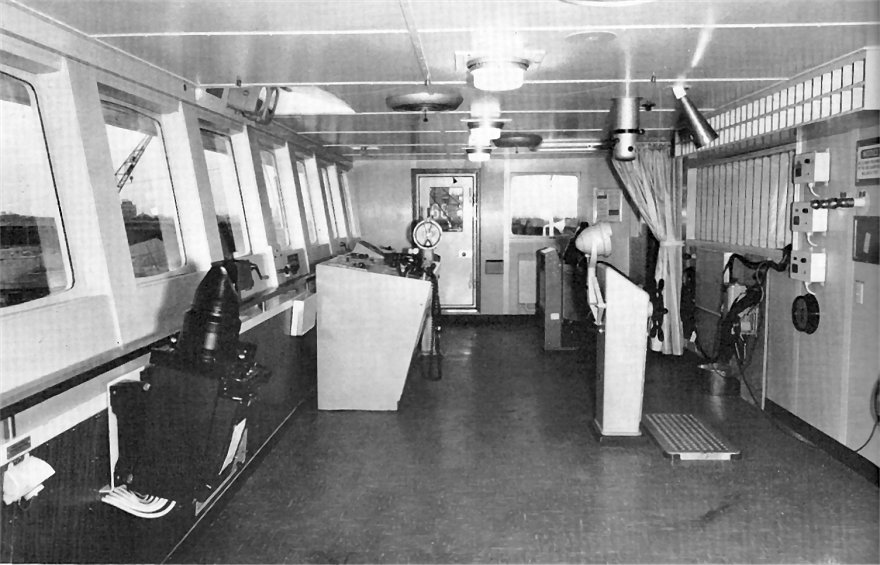 Partial view of the navigation bridge on the ESSO HOUSTON. Control console can be seen in the left background.
The latest in along and proud line of tankers built by Newport News shipbuilders was delivered to her owners on December 11. The ESSO HOUSTON (Hull 573) officially became the property of The Humble Oil & Refining Company at 4 p. m. on that date. She sailed the next day bound for Houston, Texas.
The big tanker, under construction in the Yard since last January, was launched September 26 from Shipway 8. The ship's outfitting period was completed at Pier 1 and successful sea trials were conducted on December 7-8.
This tanker is one of the most modern and efficient in the world. She is 800 feet in length, has a beam of 116 feet and the absence of a rnidship deckhouse will present a new look in the Humble fleet.
She has been designed with economy, automation, and efficiency features which, combined with lower maintenance requirements, are expected to set new standards in the transportation of petroleum from U. S. gulf ports to the Atlantic seaboard.
Newport News shipbuilders fit together approximately 50,000 individual pieces of steel, weighing about 15,700 long tons, to build the ESSO HOUSTON.
More than 300,000 pounds of welding metal and 30,000 rivets were used by hundreds of welders and riveters to fasten these pieces together to form the ESSO HOUSTON.
The propulsion and machinery components which will drive the ESSO HOUSTON are the ship's most outstanding and unique features. The basic concept of using a single automated boiler, in contrast with the two boilers employed on many other ships, is being used for the first time on an ocean vessel of the ESSO HOUSTONís size.
The ship's machinery spaces have been simplified for the possible operation of the entire plant from a single control console.
The ESSO HOUSTON is driven by a 23-foot, four-bladed, manganese, bronze propeller weighing 70,750 pounds.
The ESSO HOUSTON is equipped with the most rnodern aids to navigation and safe ship handling.
A direct-reading loran receiver-indicator provides the Master with continuous information on the position of his ship when it is within range of loran stations.
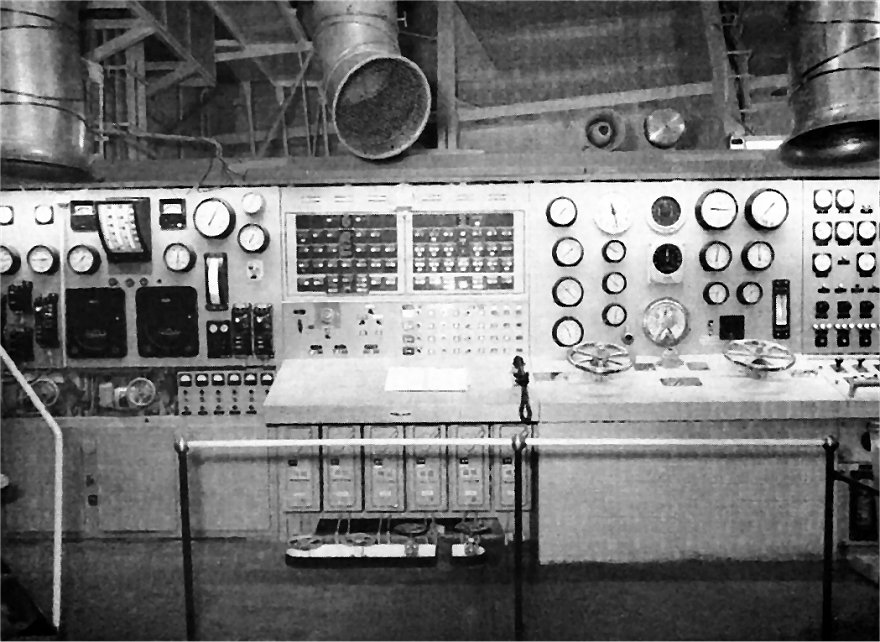 The compact engine and boiler control panels for the ESSO HOUSTON. Controls are automated for entire operation by a limited number of engineering personel.
The gyroscope compass and automatic steering equipment also contribute to safe navigation.
The three-story high, 96,500-pound rudder is operated by two hydro-electric units. The rudder can he turned through an arc of 70 degrees in 25 seconds.
Radio equipment includes main, emergency and high frequency transmitters, main and emergency intermediate frequency receivers, a high frequency receiver, a crystal receiver and a radio direction finder.
A twelve-station public address talk-back system provides for intra-ship communications. Orders and information can be passed over this system swiftly and accurately. It is particularly useful during mooring and unmooring operations.
The tanker has two bow anchors and a stern anchor, each weighing 25,470 pounds. The use of the stern anchor for maneuvering in crowded waterways or in treacherous currents is another means of insuring safe ship handling and mooring.
Because of the tremendous size and weight of the ship. eight mooring winches equipped with 1 1/2-inch plow-steel mooring wires and fitted with hydraulic brakes have been installed for safe ship handling.
All living spaces for ollicers and crew in the ESSO l-lOUSTON are fully insulated and air-conditioned.
The paneled walls and the rubber-tiled composition decks are cheerful in color and easy to maintain.
All of the officers and crew members are quartered in the deckhouse located on the after section of the ship.
Each crew member has his own room with a built-in metal bed with four drawers and a locker underneath. Each room has a wardrobe, desk, bookrack, reclining lounge chair, armchair, and washbasin with hot and cold water, a radio shelf and an outlet connected to a master radio antenna.
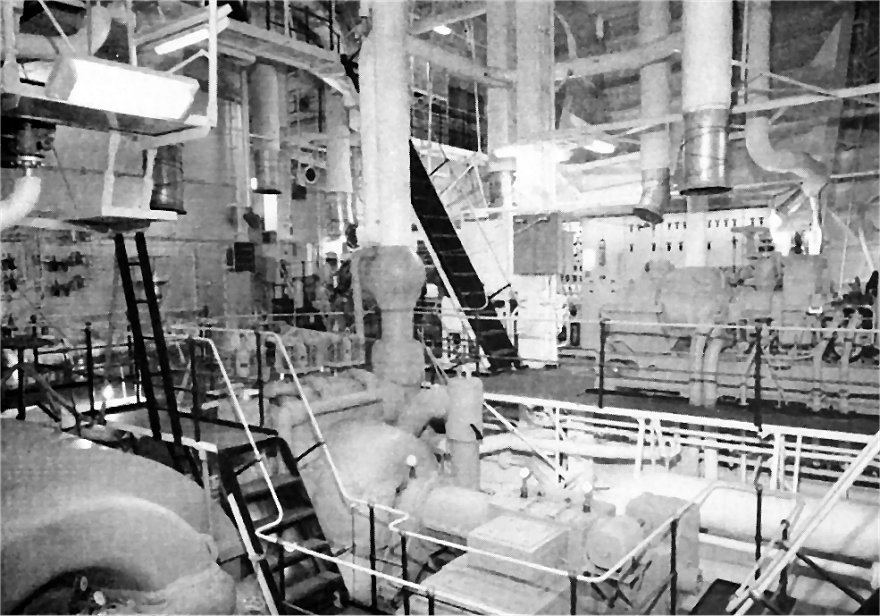 View in the modern engine room of the ESSO HOUSTON. The high and low pressure turbine units in the foreground.
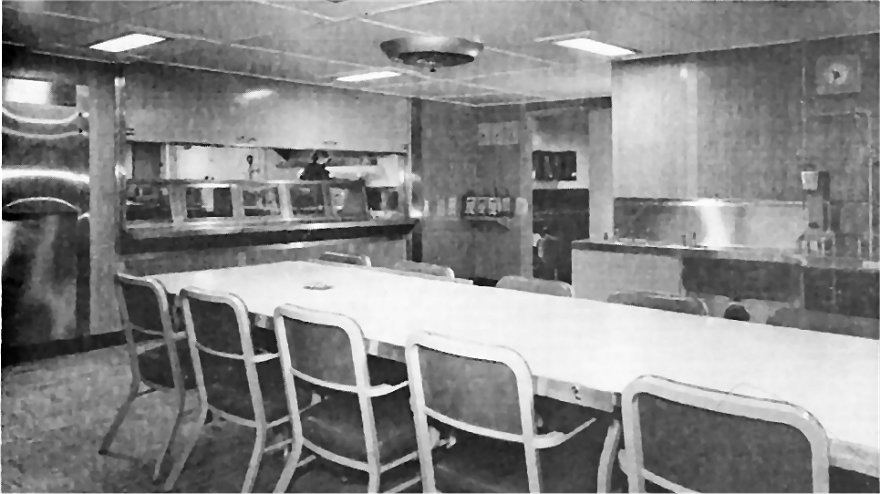 A partial view of the crew's messroom. All of the bulkheads are simulated almond walnut wood. Decks are covered in green tile.
The galley is a chef's delight. The new and efficient arrangement of the centrally located electric ranges and work tables keeps the effort used in the preparation of food to a minimum. Food service windows to the mcssrooms allow speedy service. A reach-through refrigerator between the galley and the serving pantry keeps salads and similar foods crisp and fresh for serving.
Because tanker men spend so much of their time at sea, particular attention has been paid to the recreation and lounge areas of the ship. These are spacious, comfortably furnished, and provided with television sets.
Safety has been a major consideration in every section of the ESSO HOUSTON. The hull has been designed and built for excellent seawortliiness and "sea keeping" qualities. Machinery and equipment have been selected for reliability and efficiency.
All sorts of instruments, gauges and electric and electronic devices provide deck and engine personnel with modern aids to safe navigation, communication and efficient power plant operation.
Although extensive precautions have been taken to prevent the outbreak of fire, elaborate fire-fighting equipment is provided. Outstanding is the newest type of foam fire-extinguishing system.
A full range of life-saving apparatus is aboard the ship. Included are two 35-person diesel-propelled lifeboats, a portable buoyant lifeboat radio transmitter rteceiver and life jackets. Fresh air masks, a rescue breathing apparatus and a resuscitator are provided
for emergency operations.
There are many features of the ESSO HOUSTON designed to minimize the chances of personal injury accidents. Interior and exterior ladders, for instance, have an easier slope than on most ships, some as much as 45 degrees, and the incline ladders have steps instead of rungs. Many of the interior stairways have a slope of 40 degrees. Spaciousness is striking in the engine room, the deckliouse and on deck.
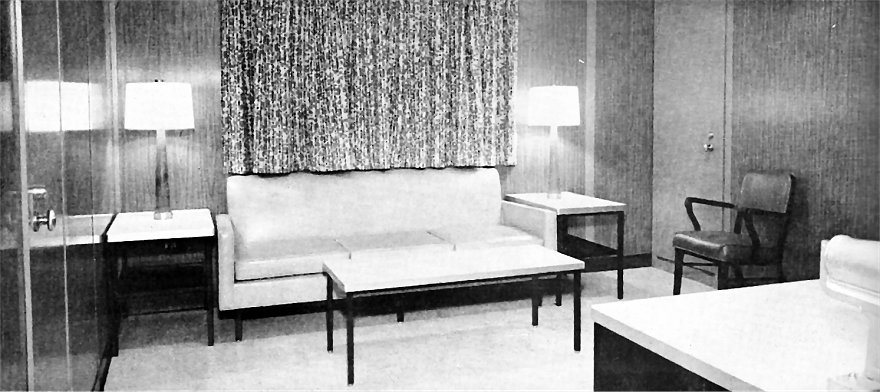 The Master's office is paneled with a simulated wood material-teak ceylon. The deck is ivory tile and the chairs are gold and red.
|